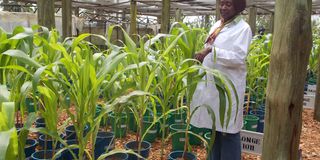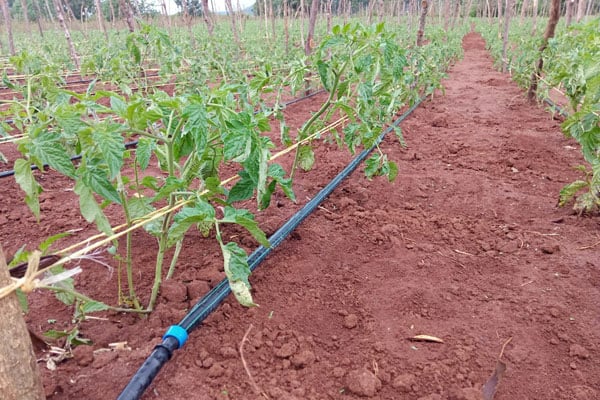New effort to produce low cost fertiliser from air

Dr Stella Kabiri examines some of the maize plants on which the plasma nitrogen fertiliser has been applied. Photo/Michael J Ssali
What you need to know:
In an effort to overcome the challenge, a new technology, the first of its kind in the world, to produce low cost and highly effective fertiliser using air as row material has been installed in Uganda.
It is widely acknowledged that increased fertiliser usage is one of the key strategies that we must adapt to boost agricultural production and productivity.
Agriculture is central to Uganda’s economic growth and poverty reduction since it employs more than 70 percent of our households and contributes about 40 percent of the country’s exports.
Increased use of fertilisers is also stressed in Vision 2040 which aims at transforming Uganda from a predominantly peasant and low-income country to a competitive upper-middle-income country.
Abuja Declaration
The Abuja Fertiliser Summit 2006 Declaration recommended that African countries apply 50 kilogrammes of nutrients per hectare in order to achieve the Comprehensive African Agricultural Development Programme (CAADP) target of six percent annual growth in the agricultural sector.
In our National Fertiliser Policy whose foreword was authored by then minister of Agriculture, Vincent Ssempijja, it is stated: “Uganda is far from achieving this target, and its loss of soil nutrients remains one of the highest in Africa. To reverse the situation, Government must address the binding constraints to the development of the fertiliser sub-sector. The fertiliser market remains underdeveloped and fragmented and has persistent gaps in the legal and regulatory frameworks.”
On December 5, 2019 the Alliance for a Green Revolution in Africa (AGRA) appealed for increased use of inorganic fertiliser in sub-Saharan Africa to overcome chronic food insecurity. The anti-hunger body observed, “For all of the signs of progress, the African continent is largely food insecure with current yields of cereals and legumes at only 15–30 percent of the potential.” On the same day in Nairobi, AGRA also launched a book titled: “Feeding Africa’s Soils: Fertilisers to Support Africa’s Agricultural Transformation” in which it was argued that increasing targeted fertiliser application by 20 percent would, for example, raise yields of rice by 5.1 percent, wheat by 11 percent, and maize by 9.9 percent.
Fertilisers
It was further said that although organic fertilisers are important in improving soil fertility, they cannot supply all the required nutrients. For example, crop residues contain only up to 4.2 percent of the six primary and secondary nutrients, while poultry manure, the richest type of manure, has only up to 15 percent nutrients.
However the big majority of African farmers cannot afford the cost of fertilisers whose prices have actually been rising in the recent months. Transportation of the fertilisers from shops to the farms on hired motorcycles or trucks makes them even more expensive for the farmers which leads to minimal usage of fertilizer by farmers and the subsequent low agricultural production.
It has also been observed that the production process of inorganic fertilisers is among the biggest emitters of Carbon Dioxide, a green gas, which is responsible for global warming.
Yet global warming which is real today is seen as the biggest threat to agriculture in a world whose population is growing rapidly, posing a bigger demand for food. Organic fertiliser (livestock droppings and rotting plants) is also said to emit methane which is another greenhouse gas responsible for global warming. We are therefore torn between a rock and a hard place --- to use the existing fertilisers for increased agricultural production and increase global warming or not to abandon them and face starvation.
New technology
In an effort to overcome the challenge, a new technology, the first of its kind in the world, to produce low cost and highly effective fertiliser using air as row material has been installed in Uganda. The technology dubbed “plasma technology mini-fertiliser plant” is located at the National Agricultural Research Organisation (NARO) laboratory at Kamenyamiggo Station in Lwengo District. It is headed by a Ugandan scientist, Dr Stella Kabiri, who works in collaboration with Eindhoven University in the Netherlands.
According to Dr Kabiri, plasma is considered as the fourth state of matter which makes up 99 percent of the visible universe. Plasma is generated by ionisation of gases using an electric current. She further explains that plasma nitrogen fixation is the reaction of nitrogen with oxygen or hydrogen to produce nitrogen oxide (nitric acid) or ammonia, respectively, under plasma conditions. She goes on to say that plasma assisted Nitrogen fixation technology provides a simple and energy efficient process for the preparation of nitrogen compounds that can be assimilated by plants. “In plasma assisted Nitrogen fixation technology synthesis, the raw material is air (nitrogen + oxygen), which is abundantly available and free.”
The fertiliser that is processed by the technology is in liquid form and colourless. “The mini-fertiliser plant produces nitrogen-based liquid fertiliser while running on solar energy, water and air as a raw material,” Dr Kabiri says. “The plant uses a small-scale Plasma reactor that is sustainable, efficient, simple and very fast.” The technology which solely relies on solar power has low energy demand. Once you switch it on it begins to produce the liquid fertiliser.
How it works
Her technology demonstrates that the much needed nitrogen-based fertilisers can be produced in forms and concentrations most available for plants by using air as the raw material. She says: “The use of air, water and sun –which is abundant in Africa -- to produce liquid nitrogen based fertilisers points to cost effective benefits for site-specific mini-fertiliser plants. It makes the fertiliser more affordable and highly sustainable.”
Dr KAbiri, who made a presentation at the recent Climate Change Conference in Glasgow UK, goes ahead to point out that the manufacture of the commonly used synthetic fertilisers through what is referred to as the Harber-Bosch process has served to provide food to 40 percent of today’s population but it emits 830 mega tons of Carbon Dioxide annually which makes it one of the leading environmental polluters.
Profitability
Dr Stella Kabiri’s plasma technology mini-fertiliser plant which uses zero carbon process to produce fertilisers seeks to ostracize the Harber-Bosch process which is so environmentally risky apart from its products being so expensive.
The good news is that it will be possible to replicate the plasma technology mini-fertiliser plant and make it widely available to farmers across the country and even beyond. “In their groups farmers can pool resources and buy the plants, each one of which costs about a million and half shillings,” she told Seeds of Gold.




